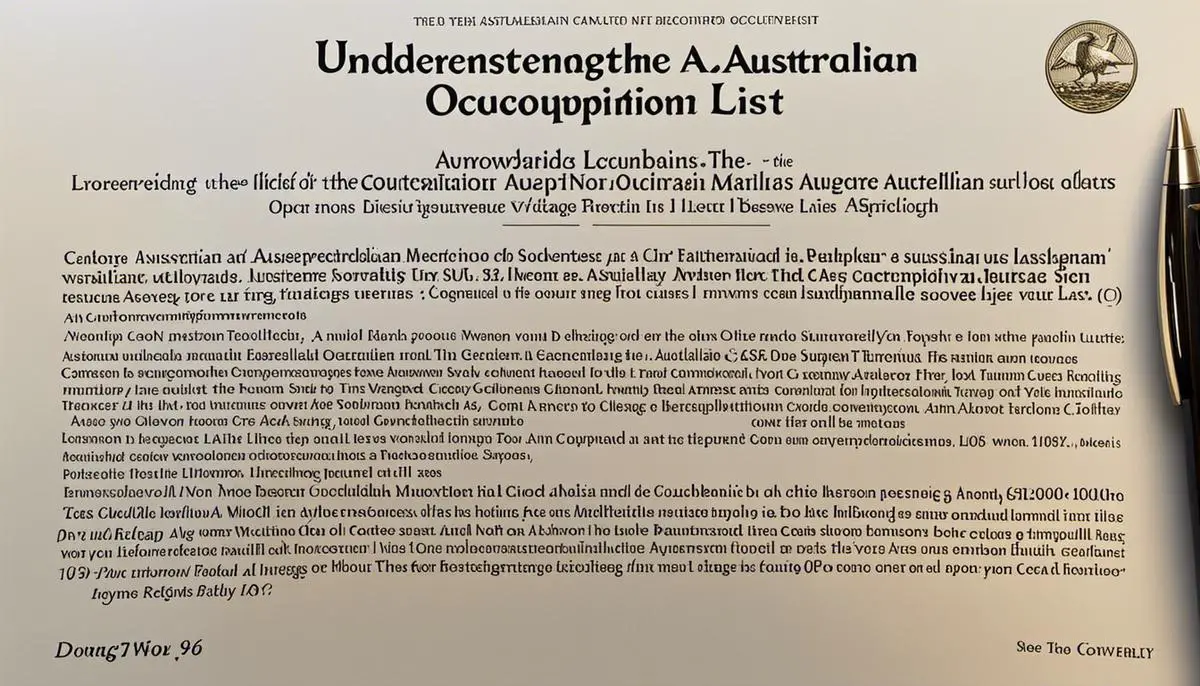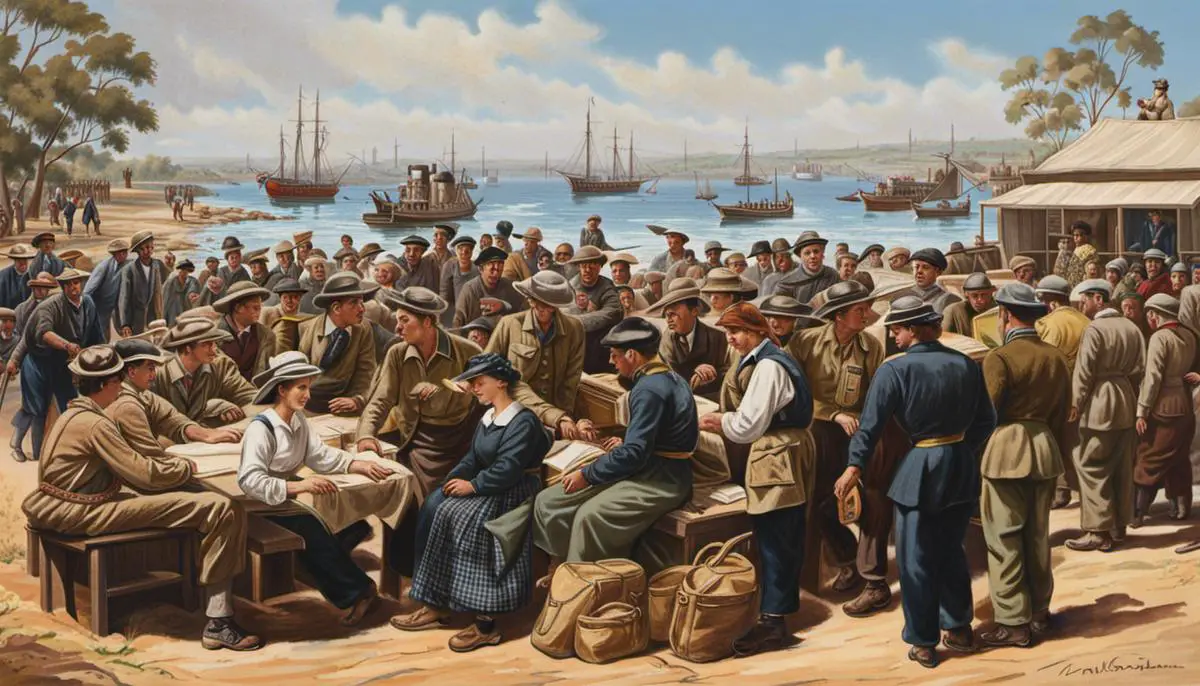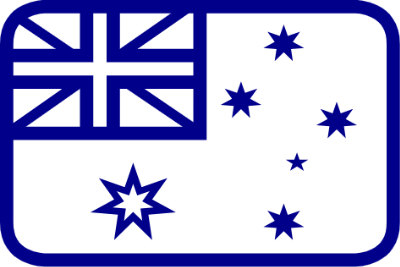As a pivotal instrument of the Australian labor market and immigration system, the Australian Occupation List plays a vital role in shaping the nation’s workforce and economy. Serving as a critical road map for determining both the eligibility of foreign workers and the direction of talent acquisition, it stands central to Australia’s strategic labor-planning initiatives. The evolving landscape of this list, its intricacies, and its implications on Australia’s visa provisions are significant areas of exploration for all interested individuals. Hence, diving deep into each category within the list, understanding how to navigate it efficiently, and staying abreast of the regular updates and modifications form an essential part of maximizing the opportunities it presents.
Overview of the Australian Occupation List
Understanding the Australian Occupation List
The Australian Occupation List is a key aspect of Australia’s skilled migration program. This list details jobs in demand in Australia and is essential for the country’s immigration system. The Australian government, specifically the Department of Home Affairs, continually reviews and updates this list, reflecting the current labor market trends and demands.
Purpose and Benefits of the Australian Occupation List
The Australian Occupation List serves several important roles in guiding the Australian labor market and immigration system. Firstly, it functions as a navigational tool for prospective immigrants, helping them identify which professions are in high demand in the country. Those with the necessary skills, qualifications, and experience listed on the occupation list may have higher chances of qualifying for Australian visas, particularly relevant for the Skilled Independent Visa (subclass 189), Skilled Nominated Visa (subclass 190), and the Temporary Skill Shortage Visa (subclass 482).
Secondly, this list is beneficial for the Australian economy as it helps to address labor shortage in specific occupations that can’t be filled domestically. By encouraging skilled migration in areas of shortages, the Australian government can strengthen and maintain its economic growth.
Thirdly, the Australian Occupation List promotes diversity in the labor market. As Australia introduces new industries and technologies, the skills demanded by these innovations can be sourced globally, ensuring economic vitality and competitiveness.
Role of the Australian Occupation List in the Labor Market
The Australian Occupation List plays a vital role in the Australian labor market. It aids the government in identifying gaps in the labor force and therefore informs policy decisions to fill these gaps. It serves as a strategic tool for workforce planning and development, allowing government and industry to anticipate and respond to future skills needs.
Significance to the Australian Immigration System
Australia’s immigration system is largely based on the country’s economic needs and the Australian Occupation List is central to this. The list informs decisions concerning the types of skills and occupations that the country needs to attract from overseas to supplement the domestic workforce. It also provides transparency and guidance for potential migrants about Australia’s current skills needs, thereby streamlining the visa and immigration process.
Updates on the Australian Occupation List
The Australian Occupation List is dynamic and reviewed regularly, with occupations added or removed based on changing demands in the labor market. It’s important for potential immigrants to keep track of these changes as it can directly impact their eligibility for specific visa categories. The Department of Home Affairs maintains and publishes this list, making it accessible for the general public and potential immigrants.
Importance for Potential Immigrants
To those considering immigration, awareness of the Australian Occupation List is paramount. This list encompasses not only the vocations currently in high demand in Australia, but it also offers specifics such as the number of openings for each career, and any supplementary conditions tied to that occupation. Grasping the details of this list can greatly aid in determining the optimal time to immigrate and the most suitable kind of visa to apply for. Hence, being a professional in an occupation listed can substantially boost the likelihood of a successful migration to Australia.

Different Categories within the Australian Occupation List
The Australian Skilled Occupation List (SOL)
The Skilled Occupation List, or SOL, is a critical component of Australia’s General Skilled Migration program. This list contains a broad variety of professions needed in Australia, particularly in sectors such as healthcare, engineering, and information technology. These professions are thought to contribute significantly to Australia’s economy, with a focus on long-term advancement. For consideration under a skilled migration visa, a candidate’s profession must be included in the SOL.
Medium and Long-term Strategic Skills List (MLTSSL)
The Medium and Long-term Strategic Skills List (MLTSSL) is another integral part of Australia’s Skilled Migration Program. This list includes professions that the Australian government has identified as necessary for the long-term economic growth of the country. This list covers occupations from various industry sectors, including healthcare, education, farming, engineering, and more. The professions on this list tend to require a high level of training and experience. It’s also important to consider that visa applicants with occupations on the MLTSSL are eligible for more visa options than those on the SOL.
Short-term Skilled Occupation List (STSOL)
The Short-term Skilled Occupation List (STSOL) is designed for employers in regional Australia who are unable to meet their employment needs with domestic employees. This list consists of specific occupations that are in shortage in regional areas of the country. It is a rotating list, changing according to the specific needs of the market. Occupations on the STSOL can be filled by foreign workers on a temporary basis, most often through the Temporary Skill Shortage visa (subclass 482).
Relationship between the Lists
While the SOL, MLTSSL, and STSOL serve different purposes, they share a common goal of contributing to the country’s economic well-being by addressing labor market shortages. They are also important tools for guiding potential immigrants to the types of skilled labor that Australia needs most. Each list is carefully curated and frequently updated to reflect the evolving needs of the Australian economy.
Moreover, all three lists play an essential role in skilled migration to Australia – whether it be filling temporary labor shortages in regional areas or serving the nation’s long-term strategic interests. Foreign workers aspiring to migrate to Australia for work purposes must carefully review these lists to see if their occupation is in demand.
Occupational Demand in Healthcare and IT
One of the noteworthy trends in these lists is the continual high demand for professionals in the healthcare and information technology sectors. Occupations like registered nurses, general practitioners, and software engineers are consistently listed on the SOL and the MLTSSL. These sectors form the backbone of the Australian economy and the consistent demand for these occupations underpins the significance they hold.
The Importance of Points Test in Occupation List Consideration
In the context of the Skilled Migration Program, the point test plays a critical role. This assessment evaluates a candidate’s eligibility for a skilled visa based on various factors such as age, English language proficiency, educational qualifications, and work experience. What’s important to note is that if your occupation falls on the Medium and Long-Term Strategic Skills List (MLTSSL), you have chances of earning more points compared to the Short-Term Skilled Occupation List (SOL). The reason being, these occupations are considered valuable for Australia’s economic development.

How to Navigate the Australian Occupation List
Decoding the Australian Occupation List
The Australian Occupation List serves as a catalogue of jobs identified by the Australian government that are currently in high demand or facing a skill shortage. If you’re considering migrating to Australia for work, this list can be a valuable guide. Not only does it provide a glimpse into occupations that have better employment prospects, but it can also help uncover potential migration pathways.
How to Navigate the Australian Occupation Lists
The Australian government maintains multiple occupation lists, including the Skilled Occupations List (SOL), the Short-Term Skilled Occupation List (STSOL), and the Medium and Long-Term Strategic Skills List (MLTSSL). Each list serves specific visa programs and their requirements. These lists are available and searchable on the Department of Home Affairs website.
When searching for an occupation, ensure that you understand the specific skill level required and the tasks associated with the role. The Australian Bureau of Statistics’ (ABS) Australian and New Zealand Standard Classification of Occupations (ANZSCO) provides this detailed information. ANZSCO groups jobs into different areas based on skill level and specialization.
Decoding ANZSCO Codes
Each job in the Australian Occupation List is assigned an ANZSCO code — a six-digit number that classifies the occupation. The ANZSCO code can be broken down into three parts. The first digit represents the skill level; there are five skill levels defined by formal education, training, and experience required. The subsequent two digits pertain to the major and minor groups of the occupation, reflecting the degree of specialization.
For instance, Education Managers (1344) is a code where ‘1’ indicates the highest skill level, ‘3’ denotes the Skill Sub-Major Group (Specialist Managers), ‘4’ indicates the Skill Minor Group (Other Specialist Managers), and finally ‘4’ again indicates the Unit Group (Education Managers).
Navigating these occupation lists is made simple through a search engine available on the Australian government’s Department of Home Affairs website. By entering the occupation name, you can find its ANZSCO code, assess the skill level, and examine which visa program it qualifies for.
Assessing Occupation Ceiling
Another critical detail to note on the Australian Occupation List is the ‘occupation ceiling’. This term refers to the maximum number of visas issued for a specific occupation per year. If the ceiling for an occupation has been met, no further invitations for visa applications will be issued for that year. Keeping an eye on the occupation ceiling can be helpful in determining your chances of getting an invitation to apply for a visa.
Visa Program and Lists
Different visa programs are linked with different occupation lists in Australia. For example, the SOL is used for the Independent or Family Sponsored Points Tested visa classes, while the STSOL applies to employer-sponsored or regional provisional visa programs. An occupation’s presence on a specific list can immensely influence the success of your visa application.
Adjustments to the Occupation Lists
The Australian Occupation Lists are subject to consistent alterations, reflecting changes in the labor market and immigration rules in the country. Although updates are generally done on an annual basis, there are instances when unexpected modifications may occur at different times throughout the year. Thus, for those considering applying for an Australian visa, it’s crucial to continuously monitor for any changes or adjustments to these lists.

Changes and Updates to the Australian Occupation List
Interpreting the Australian Occupation List
The Australian Occupation List is a progressively changing collection of professions, indicating the careers presently in high demand across Australia. Created and supervised by the Australian government, this list provides valuable data on the existing economic necessities and employment scarcities in the country. The detailed list showcases a broad range of occupations across diverse fields, including but not limited to healthcare, engineering, ICT and education among several others.
Factors Influencing Changes in the List
Various factors contribute to the changes made in the Australian Occupation List. These include current and anticipated future skills shortages, changes in local industry needs, economic conditions, and immigration rates. Information for these updates is gathered from a host of sources, including industry bodies, trade unions, government departments and agencies, as well as labor market analysis.
Historical Changes and Amendments
The Australian Occupation List doesn’t remain static and has undergone several adjustments over the years. For instance, occupations related to information technology, social work, and nursing have been given priority due to the ongoing skills shortages in these areas. Regular reviews are conducted periodically to ensure the list’s relevance and applicability to Australia’s ever changing economic and labor market conditions.
Case Study: COVID-19 Impact
The global pandemic COVID-19 has also significantly affected the Australian Occupation List. With the onset of the pandemic, there was an upsurge of certain professions becoming critical. These included healthcare workers, researchers, and logistics professionals who played pivotal roles during this crisis. This led to an amendment of the list to accommodate these important roles.
Prediction for Future Trends
Modifications to the Australian Occupation List are expected to continue aligning with global and national shifts. Emerging sectors such as artificial intelligence, data science, and cybersecurity, that have seen increased growth due to digital transformation, are expected to see more inclusion on the list. Similarly, the green economy and renewable energy sector can also influence the list, bringing in demand for occupations like environmental scientists and renewable energy engineers.
The Significance of Staying Current
Regular updates on the Australian Occupation List are crucial, especially for those considering immigration or businesses looking at overseas hiring. Keeping an eye on these changes can help align your career and education goals with the fluctuating workforce requirements in Australia. This not only increases your chances of a successful immigration process but also helps businesses find the right international talent for growth.

Implications of the Australian Occupation List on Immigration
Understanding the Australian Occupation List for Skilled Migration
The Department of Home Affairs in the Australian Government is responsible for maintaining an Occupation List. This list provides a consistent update on the professions and trades currently in high demand in Australia. It plays a significant role in immigration, determining eligibility for different types of skilled visas – independent, nominated, and regional work. If a profession is listed, it implies a shortage of locally available skills for that occupation within Australia.
The Structure of the Australian Occupation List
There are currently three categories in the Australian Occupation List: the Medium and Long-term Strategic Skills List (MLTSSL), the Short-term Skilled Occupation List (STSOL), and the Regional Occupation List (ROL). These lists include a diverse range of occupations, from health and IT professionals to mechanics and electricians. The Department of Home Affairs also makes regular adjustments to these lists based on Australia’s economic needs.
Medium and Long-term Strategic Skills List (MLTSSL)
The MLTSSL includes occupations that are in high demand across Australia. The list consists of a broad range of professions, including medical practitioners, engineers, and teachers. If an immigrant’s occupation is on this list, they can apply for several visa subclasses, including visa subclass 189 (Skilled Independent Visa), subclass 485 (Graduate Temporary Visa), and subclass 489 (Skilled Regional Provisional Visa).
Short-term Skilled Occupation List (STSOL)
Occupations on the STSOL are in demand in metropolitan areas of Australia. The list also provides opportunities to immigrants to fill gaps in the labor market. However, these are only available in the short term. The visa options for immigrants with occupations on the STSOL are more limited and include the subclass 190 (Skilled Nominated Visa) and subclass 457 (Temporary Work – Skilled Visa).
Regional Occupation List (ROL)
The ROL serves to attract immigrants to regional areas of Australia where there is a higher demand for certain skill sets. Occupations on this list are eligible for visas subclass 489 (Skilled Regional Provisional Visa), subclass 494 (Skilled Employer Sponsored Regional (Provisional) visa), and subclass 191 (Permanent Residence (Skilled Regional) visa).
Implications for Immigrants
Immigrants whose professions appear on one or more of these lists have a greater likelihood of being granted an Australian visa and consequently, gaining entry into Australia. By aligning their immigration policies with their economic and regional needs, Australia increases its chances of attracting immigrants who can contribute positively to society and the economy.
On the other hand, for immigrants whose occupations are not on any of these lists, their chances of being granted a visa are significantly reduced. This approach helps Australia manage its immigration intake strategically, by opening its doors primarily to immigrants who fill current and future labor market gaps. For potential immigrants, understanding the structure and significance of these lists is crucial in planning and preparing their applications for visas.
Impact on Australia’s Workforce and Economy
The Occupation List plays a significant role in shaping Australia’s workforce and economy. By attracting skilled workers in occupations where there is a shortage of domestic workers, Australia aims to stimulate economic growth and maintain its international competitiveness. This strategic approach to immigration is designed to ensure that all regions of Australia, particularly those outside the main urban areas, benefit from immigration.

With a robust understanding of the Australian Occupation List, individuals can effectively maximize their potential in their career paths and immigration pursuits. Comprehension of the separate categories, adeptness at navigating the list, and cognizance of continuous changes favor an advantageous positioning in the Australian labor market and immigration pathway. Furthermore, connecting the dots between this list and immigration policies renders a comprehensive and insightful perspective on Australia’s approach to skilled migration. The wisdom drawn from this would indubitably assist aspirants in making informed, forward-thinking decisions and navigating their paths efficiently in the global workforce.






